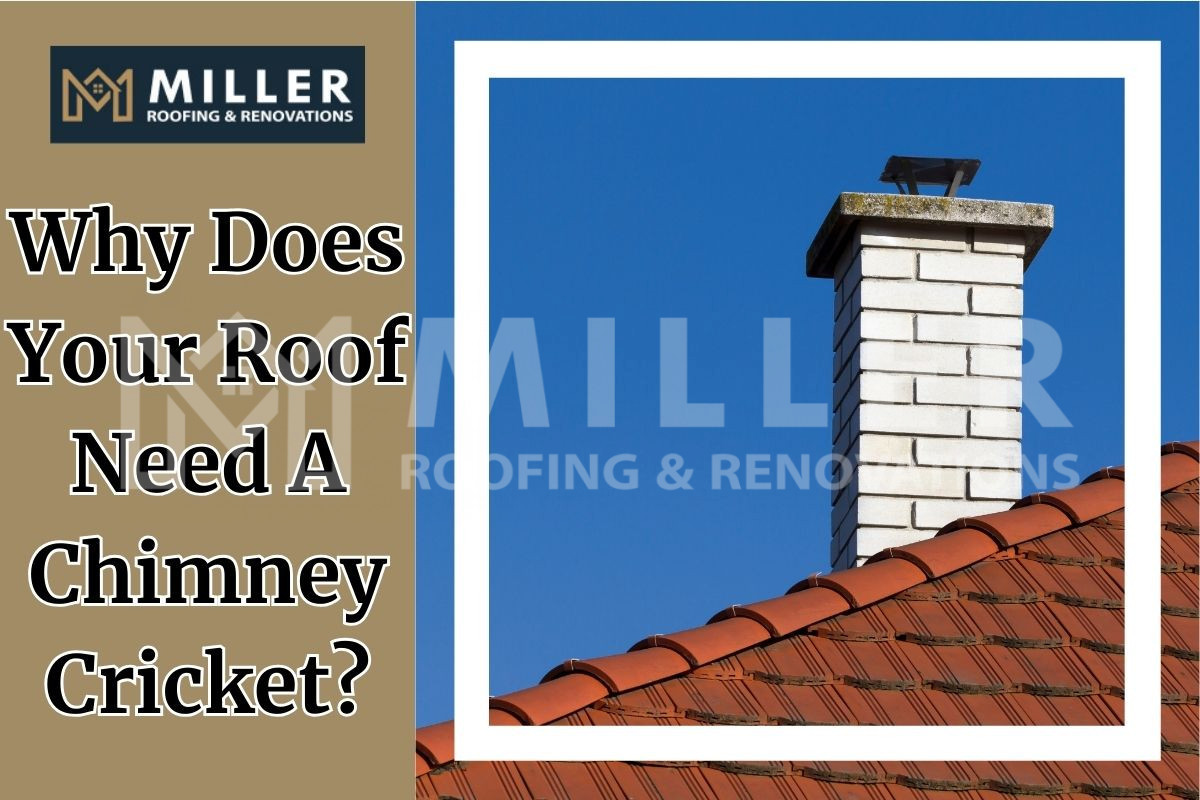Have you ever observed a small, peaked structure that rises from the back of chimneys, resembling a ridge? That’s known as a chimney cricket, and it’s vital in both safeguarding the longevity of your roof and preventing water damage. The value of chimney crickets in protecting your house from water damage cannot be emphasized enough, even if they may not be the most appealing aspect of your roof.
Let’s learn about the importance of chimney crickets in regards to the health of your roof, their life cycle, and the dangers of ignoring them with this blog post.
What Is A Chimney Cricket?
To deflect water away from the base of the chimney where it enters your roof and stop leaks, a chimney cricket, sometimes called a saddle, is constructed behind the chimney and connected to the rest of the roof. By diverting water away from the chimney and down the slopes of the roof, this triangle or pyramid-shaped structure helps shield your roof from leaks, rot, and other forms of damage over time.
It also helps keep snow and debris from building up behind the chimney, increases energy efficiency by reducing heat loss and air leaks, and improves the overall look of your house. Investing in a chimney cricket is crucial to protect your roof and chimney from water damage and extend its lifespan.
What Is The Importance Of A Chimney Cricket?
1. Water Protection:
By deflecting water away from the base of the chimney, the chimney cricket keeps it from ponding on the roof and forming damage like decay and leaks.
2. Debris and Snow Prevention:
The cricket prevents snow and debris from building up behind the chimney by diverting water away from it. This keeps the chimney and roof stable, especially in regions with a lot of snowfall or debris.
3. Energy Savings:
By minimizing air leaks and heat loss, properly installed chimney crickets can increase the energy efficiency of a dwelling. Typically, you’ll end up saving a bit more on your energy bills due to the cricket.
4. Extended Roof and Chimney Life:
A chimney cricket prolongs the life of the roof and chimney by preventing water damage and lowering the possibility of leaks. This is a wise investment since it will eventually result in lower repair expenses.
5. Improved Appearance:
A chimney cricket adds a polished aspect to the roofline, which can add to the appearance of a house in addition to its practical benefits. This enhances the overall appeal of the home, which may draw in more buyers.
What Is The Difference Between Roof Flashing And A Chimney Cricket?
Though both chimney crickets and roof flashing aim to redirect water from gaps in the roof, they vary in their design and purpose. Chimney crickets are tailored specifically for installation behind chimneys on sloped roofs, with a focus on preventing water from seeping and pooling behind the chimney. On the other hand, roof flashing is placed at different points on the roof such as valleys or drip edges to keep water from infiltrating through these vulnerable areas, ultimately serving a wider function than chimney crickets.
Is A Chimney Cricket Necessary For All Chimneys?
Not every chimney needs a cricket. According to the National Fire Protection Agency, and the International Residential Building Code, cricket must be constructed to specific standards if your chimney is 30 inches wide, or wider. Measure the chimney’s width on the side parallel to the ridgeline. If your chimney is on a sloped roof, you may notice water pooling at the base where it meets the roof, making a chimney cricket necessary.
Generally, roofs with a high or steep pitch, larger chimneys, or those located at the intersection of two roof planes or in a valley are more likely to require a cricket to prevent water damage and ensure proper drainage.
Consequences of Not Having a Chimney Cricket
Here are the possible repercussions of not having a chimney cricket:
1. Water Damage
- Without a chimney cricket, water may gather behind the chimney, causing leaks and water-related damage.
- Accumulated water can seep into the roof, resulting in structural damage, mold growth, and rot over time.
2. Formation of Ice Dams
- In colder climates, the absence of a chimney cricket can contribute to the creation of ice dams on the roof.
- Ice dams can lead to water backup and infiltration into the home, causing further damage and potential leaks.
3. Compromised Structural Strength
- Chimneys are susceptible spots on roofs, especially during severe weather.
- The lack of a chimney cricket can compromise the roof’s structural strength around the chimney, increasing the risk of water-related damage.
4. Expensive Repairs
- Water damage stemming from the lack of a chimney cricket can necessitate costly repairs.
5. Long-Term Roof Maintenance
- Installing a chimney cricket maintains a roof’s long-term resilience, ensuring it can endure various weather conditions and remain structurally sound.
6. Adherence to Building Codes
- Many building codes mandate the installation of chimney crickets to meet specific criteria.
- Ensuring compliance with these codes not only enhances the safety of your home, but also prevents legal issues related to ignoring building codes.
How To Install A Chimney Cricket
Here is a brief overview on how a chimney cricket is installed, but always remember that professional installation is the way to avoid frequent repairs down the line and mistakes during the installation process.
1. Prepare the Area:
- Remove the layers of roofing material around the chimney down to the decking.
2. Construct the Cricket Frame:
- Determine the height needed and cut the frame from steel
- Construct the frame around the base of the chimney
3. Secure the Frame:
- Attach the cricket frame securely to the roof deck at the appropriate angle to prevent water pooling.
- Install a version of the ice and water protector around the cricket
4. Add Final Touches:
- Ensure that shingles are properly cut, aligned, and installed to direct water away from the chimney and prevent leaks.
How Much Does It Cost To Install A Chimney Cricket?
Factors including material costs, labor costs, and the complexity of the job might cause the cost of a chimney cricket installation to vary significantly. The price might differ greatly from one household to the next, depending on the location of the house and the chimney cricket’s size.
For chimney cricket installation, homeowners should typically expect to spend around $300 and $1,000. But in order to guarantee an exact cost estimate based on your particular requirements, it is advised that you get quotes from multiple local roofers. Get in touch with a reputable roofing contractor and ask for a custom installation estimate if you want a more exact number to base your decisions around.
Keep Your Roof Safe With A Chimney Cricket Installation
Despite their seemingly small relevance, chimney crickets play a critical function in maintaining the condition of your roof. Chimney crickets protect your investment and provide years of worry-free living by rerouting water away from vulnerable areas, avoiding the chance of water damage and leaks occurring.
Consider giving Miller Roofing and Renovations a call to install this important part of your roofing system. With our knowledge and dedication to quality, we’ll make sure that your chimney cricket is installed carefully and precisely, preserving your roof over time. To ensure that your roof is resilient and long-lasting, trust the team at Miller Roofing and Renovations for dependable roofing services. Give us a call at (901) 457-9405 to find out how we can help you.



 FREE ESTIMATE
FREE ESTIMATE